New app reveals little-known history of Rio de Janeiro port
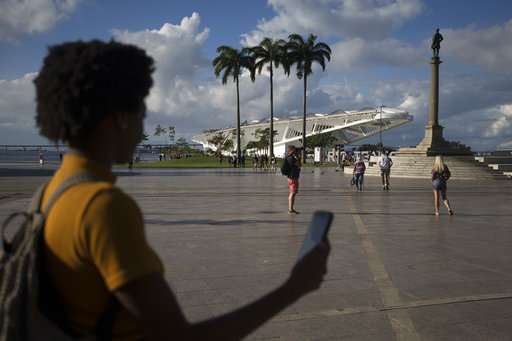
Rio de Janeiro's port area may be one of the city's most inviting spots since being renovated for the Olympic Games last year. But while the area is home to attractions that include two museums and an aquarium, its rich history remains unknown to most locals and tourists.
A new app seeks to educate visitors about the area's role in Brazilian history, from colonization and the arrival of slave ships to recent cases of corruption.
Launched in late June by the nonprofit investigative journalism agency Agencia Publica, the app called "Museum of Yesterday" offers tours of the port in Portuguese and English.
But there's a catch. Inspired by Pokemon Go, the app detects users' geo-location and only reveals the stories once users arrive at the location where the story took place.
With over 160 points of interest, the app offers five options. The terror tour explores slavery, colonization and the country's military dictatorship, along with other incidents like the 1993 Candelaria massacre in which eight people—many of them teenagers—were killed while sleeping on the steps of the Candelaria church. The corruption tour investigates bribery from the time of King John VI of Portugal to recent kickback schemes. The samba tour explores the roots of Rio's traditional Carnival music. Finally, the tour of ghosts explores important historical figures that are sometimes forgotten.
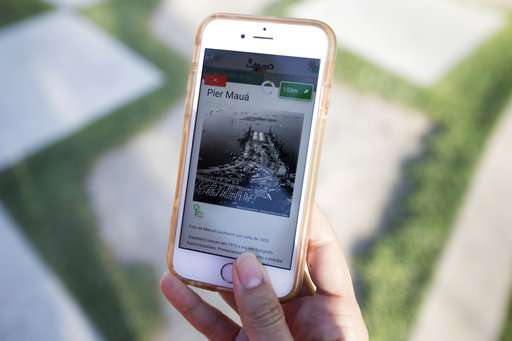
"Rio's port carries a lot of the history of Brazil," said Gabriele Roza, a journalist at Agencia Publica who contributed to the stories in the app. "What we realized was that these stories are not present here."
Indeed during the Rio Olympic Games, local authorities emphatically promoted the port's new attractions such as the futuristic looking Museum of Tomorrow designed by Spanish architect Santiago Calatrava that cost $55 million, and a new boulevard decorated by internationally acclaimed street artists.
But the city neglects other historical attractions located a few blocks away such as the Valongo Wharf, an archaeological site where hundreds of thousands of slaves debarked after their harrowing journey across the Atlantic.
Francesca Declich, an Italian anthropologist visiting the Valongo Wharf on July 9, the day it was named a UNESCO World Heritage site, complained that the wharf was hard to find and that there was only basic information available on a three-paragraph-long plaque next to the pit.
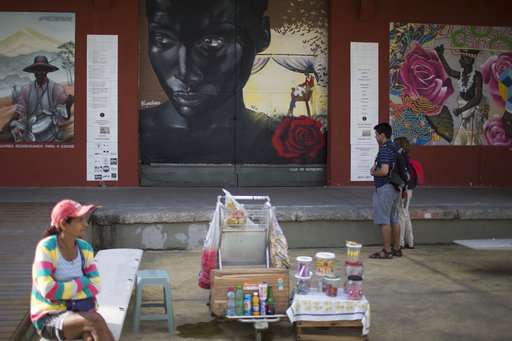
The port is also connected to the present-day Car Wash corruption investigation. For example, Eduardo Cunha, who led Brazil's impeachment effort against former President Dilma Rousseff, is now being investigated over allegations that he received $16 million in kickbacks related to the port renovation, which cost the city of Rio over $4 billion.
Rio's former mayor Eduardo Paes is also being investigated for taking bribes in the port renovation. Despite the scandal, the revitalized area is considered one of the few positive legacies from the Rio Olympics.
The app, which has been downloaded over 2,000 times so far, tells these and other stories through text but also through illustrations, photographs, audio, videos and a map from the 1830s when most of today's port was still ocean.
"As you start walking along the port area you can actually capture the stories from Rio's past and put them in a vault," explained Mariana Simoes, another journalist from Agencia Publica who was part of the team that developed the app.
"You are actually being encouraged to walk and discover the area, discover these elements of our past as you walk through them."
-
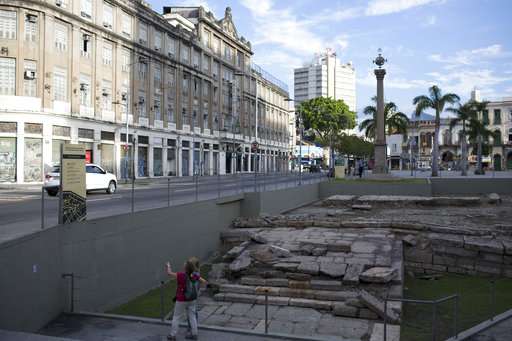
In this July 9, 2017 photo, tourists read an information sign at the Valongo Wharf where hundreds of thousands of enslaved Africans debarked from their harrowing journey across the Atlantic, in Rio de Janeiro, Brazil. The archeological pit was named a UNESCO world heritage site but tourists complain there is little information about it available on street signs. A new app called "Museum of Yesterday" seeks to educate visitors about the history and role of Rio de Janeiro's revitalized port in colonization, slavery and even recent corruption investigations. (AP Photo/Renata Brito) -
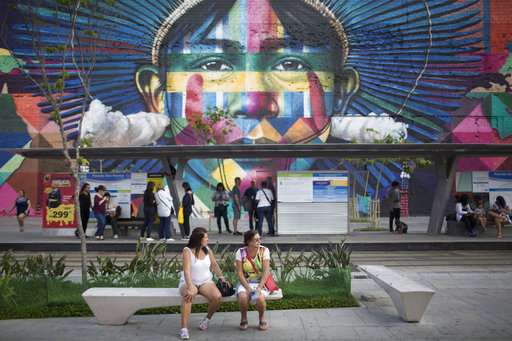
In this July 9, 2017 photo, women sit in front of a mural by street artist Kobra in the renovated port area in Rio de Janeiro, Brazil. A new app called "Museum of Yesterday" seeks to educate visitors about the history and role of Rio de Janeiro's revitalized port in colonization, slavery and even recent corruption investigations. (AP Photo/Renata Brito) -
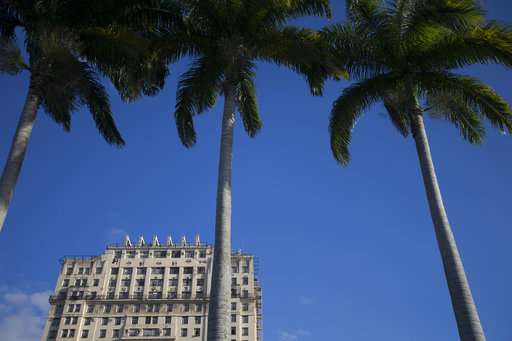
In this July 6, 2017 photo, Brazil's first skyscraper is seen behind palm trees in Praca Maua, at the heart of the renovated port area in Rio de Janeiro, Brazil. The 22-story building named "The Night" was constructed in 1929 and is part of Brazil's national heritage. A new app called "Museum of Yesterday" seeks to educate visitors about the history and role of Rio de Janeiro's revitalized port in colonization, slavery and even recent corruption investigations. (AP Photo/Renata Brito) -
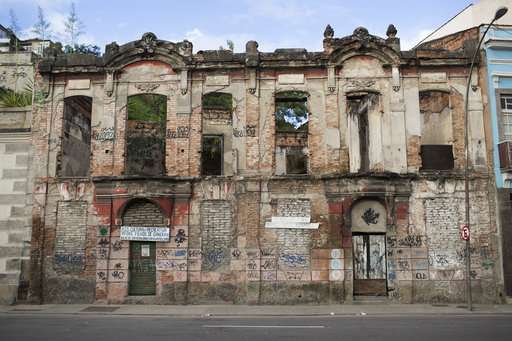
In this July 9, 2017 photo, remnants of a house that was once used a slave deposit in the late 18th century stands in the port area in Rio de Janeiro, Brazil. Before abolishing slavery in 1888, becoming the last country in the Americas to do so, Brazil was the world's largest slave market. A new app called "Museum of Yesterday" seeks to educate visitors about the history and role of Rio de Janeiro's revitalized port in colonization, slavery and even recent corruption investigations. (AP Photo/Renata Brito) -
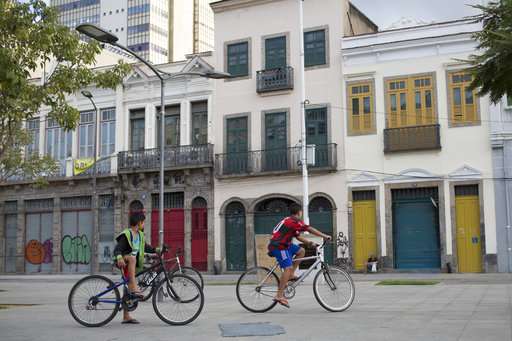
In this July 9, 2017 photo, boys ride their bikes in front of houses that were once slave deposits in the late 18th century in Rio de Janeiro, Brazil. Before abolishing slavery in 1888, becoming the last country in the Americas to do so, Brazil was the world's largest slave market. A new app called "Museum of Yesterday" seeks to educate visitors about the history and role of Rio de Janeiro's revitalized port in colonization, slavery and even recent corruption investigations. (AP Photo/Renata Brito) -
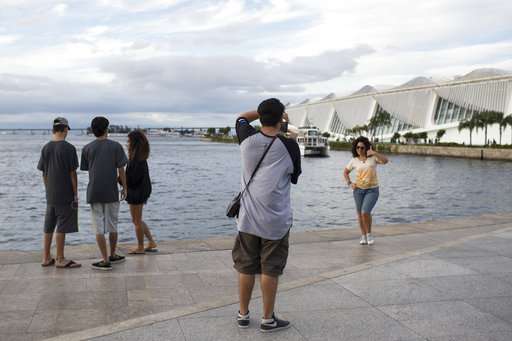
In this July 9, 2017 photo, a visitor poses for a picture in front of the Museum of Tomorrow in the renovated port area in Rio de Janeiro, Brazil. A new app called "Museum of Yesterday" seeks to educate visitors about the history and role of Rio de Janeiro's revitalized port in colonization, slavery and even recent corruption investigations. (AP Photo/Renata Brito) -
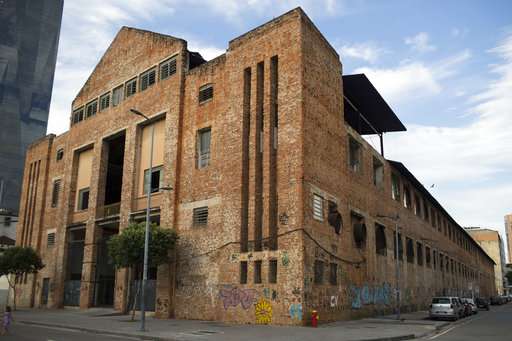
In this July 9, 2017 photo, the Docas Warehouse is seen from the Valongo Wharf, in Rio de Janeiro, Brazil. The warehouse was built in 1971 by one of Brazil's first black engineers and slave abolitionist Andre Rebouças. A new app called "Museum of Yesterday" seeks to educate visitors about the history and role of Rio de Janeiro's revitalized port in colonization, slavery and even recent corruption investigations. (AP Photo/Renata Brito) -
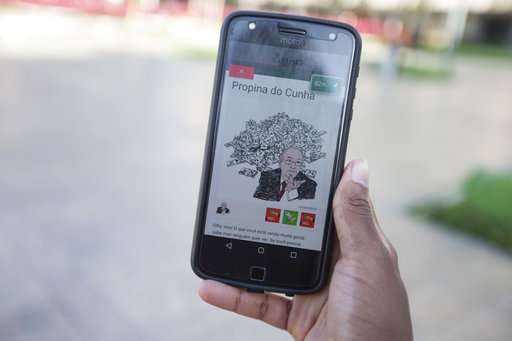
In this July 6, 2017 photo, the "Museum of Yesterday" app is seen on a cell phone showing information on kickbacks received by jailed lawmaker Eduardo Cunha, in Rio de Janeiro, Brazil. Cunha is accused of receiving 52 million reais ($16 million) in bribes related to the port renovation. He was also sentenced to 15 years and four months in prison for another corruption scheme at state-run Petrobras. The app seeks to educate visitors about the history and role of Rio de Janeiro's revitalized port in colonization, slavery and even recent corruption investigations.(AP Photo/Renata Brito) -
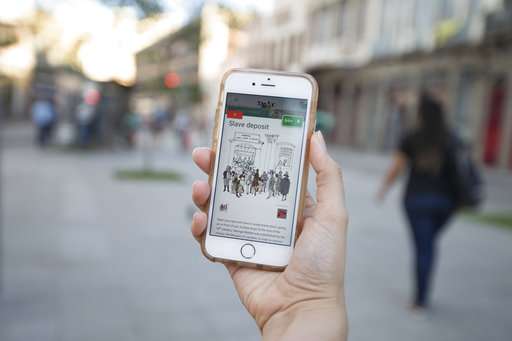
In this July 6, 2017 photo, the "Museum of Yesterday" app is seen on a cell phone showing information on slave deposits in the late 18th century, in Rio de Janeiro, Brazil. Before abolishing slavery in 1888, becoming the last country in the Americas to do so, Brazil was the world's largest slave market. The new app seeks to educate visitors about the history and role of Rio de Janeiro's revitalized port in colonization, slavery and even recent corruption investigations.(AP Photo/Renata Brito)
© 2017 The Associated Press. All rights reserved.


















